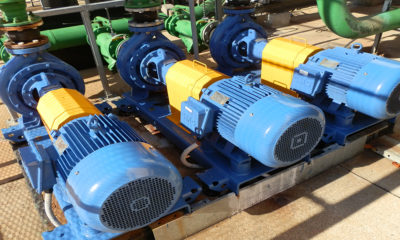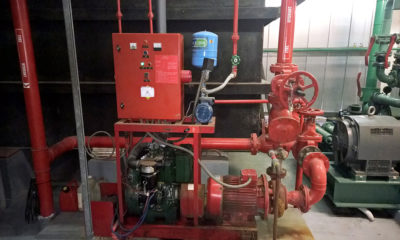Typical Water pumps which serve our buildings

It is surprising exactly how many water pumps there in a building, often with separate plumbing circuits and often more than one pump serving the same task.
A major source of energy consumption there are often opportunities to install variable speed drives to soften the start up of the pump and manage the energy consumption of the pump more effectively.
A few examples of pumps installed in commercial buildings include:
- Chilled Water
- Heating Hot Water
- Condenser water
- Sprinkler System Water
- Hydrant System Water
- Town Water
- Flusher tank water
- Grey Water
- Sump Pump
- Potable Cold Water
- Potable Hot water
- Tempered Hot water
Most of these are pumps are typically the centrifugal type.
Maintenance
These pumps require regular maintenance, but which vendor looks after which pump, can a single specialized vendor look after all the pumps or should the maintenance be subject to the discipline they serve, such as the fire services vendor looks after the fire pumps only, and so forth. What s the best and most effective pump maintenance regime? What are the advantages?
Specific Water Pumps
Lets’ take a look at the fire services pumps.
In a nut shell they are serving a plumbing circuit which runs only occasionally, that is, during monthly tests and in the event of a fire alarm. The wear and tear on these pumps is often less compared to a pump serving the chilled water circuit in a high climate building, such as Brisbane, where the pump is likely to be running 12 hours a day 5 days a week.
The fire pumps are an essential service, that is, they are there to save life and property.  They are sized and powered with a view they will run to destruction in the event of an emergency, any potential “weak points” are engineered out or minimized where ever possible. The pumps which serve the Chilled water circuit are non-essential, consequently there are engineered a little differently and are powered form the non-essential mechanical switchboard.
They are sized and powered with a view they will run to destruction in the event of an emergency, any potential “weak points” are engineered out or minimized where ever possible. The pumps which serve the Chilled water circuit are non-essential, consequently there are engineered a little differently and are powered form the non-essential mechanical switchboard.
Pump Maintenance Jargon
-
- Alignment: The pumps need to be straight when installed for correct operation, otherwise components will wear faster and efficiency will be lost costing more in energy and maintenance
- Two Way Valve: these are simply a “Gate Valve” to isolate the water from the pump for maintenance purposes.
- Check valve: These are typically installed on the discharge side of the pump, they are a “one way valve” and used when the pump has to “push up” against the head of the water, the valve stops the water coming back and trying to turn the pump backwards. Check Valves are also often used in multiple pump systems in the same circuit of water so the water doesn’t “short cycle back through the pump that is not being used
- Head Pressure: This is the water pushing back on the pump, technicians often referred to just the word “head”, it’s the water pushing back against the pump. If all the valves are closed and the water has nowhere to go, but the pump is turning the pump can become hot and fail, typically they are not design to run against a “dead head”
- Flow: Flow and pressure of water, flow is the volume, pressure is the weight behind the volume
- Coupling: this is the device which connects the shaft of the motor and the shaft of the pump
- Vibration: Like the wheels on your car, if the pump is not installed straight, the bearings are fatigued or damaged, the pump is misaligned, the coupling has a fault, or other similar issues the pump will vibrate unnecessarily causing losses in energy, efficiency and component wear and tear
- Impeller: this is the circular rotating component of the pump, if we were pumping air, it would be the fan itself.
- Variable Speed Drive: The “VSD” is often installed to provide a soft starting mechanism for the pump motor reducing energy costs and wear and tear on the pump. The VSD will often use a “high Level interface” (HLI) for communications with the Building Management System (BMS)
- Differential Pressure: In the instance of say a heating hot water pump which has two way control valves in the heating hot water circuit serving the terminal units (such as VAVs),then as these valves close the differential pressure across the system (or the heating hot water circuit) will increase until all the valves are closed and the pump is pumping against “dead head” in which case the building management System should automatically turn off the pump or modulate open the bypass valve allowing water to “short cycle” back though the boiler and of the pump, saving the pump form having to work against “dead head” which can cause catastrophic failure of the pump
Redundancy
Given the Facility Management industry is essentially a serviced based industry, we will often recommend spar pumps be kept on site for high maintenance, high priority services such as one chilled water pump set and one condenser water pump set.
As a generalization, the pump itself can sometimes “limp” along, but the electrical motor will typically fail in a single moment, trip the “current overload” safety device in the switchboard and need to be removed for repair, hence, as a minimum, having a couple of spare electric motors stored in the plant room can save considerable duress, especially in the summer months.
Your View
We’d be interested to hear your view, there is a lot of science and engineering around this subject, especially around the mathematics of pump and motor selection.
Hope to hear from you soon.
Nigel Wraight
Principle
Forte Asset Services



Thanks for sharing this article.